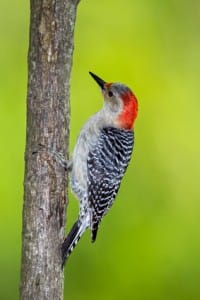 There are lots of great reasons to make your yard and garden more welcoming to birds. But here’s one more: pest control.
There are lots of great reasons to make your yard and garden more welcoming to birds. But here’s one more: pest control.
Most backyard birds eat a combination of seeds, berries and insects. But in late spring and early summer, birds are busy filling the mouths of their hatchlings, and baby birds like nothing better than freshly caught bugs.
That’s good news for gardeners, because garden pests are usually at their peak in late spring and early summer. Our bird friends can save us lots of headaches by combing our gardens for cabbage worms, whiteflies, aphids, earwigs, grasshoppers, cucumber beetles and grubs!
Following is a list of common backyard birds and the pests they eat. But first, a few tips on how to make your yard bird-friendly during the spring and summer months.
Cover: When designing a landscape to attract birds, it’s important to provide places where they can hide or take cover from the weather. During the spring and summer, birds also need nesting sites. Twiggy shrubs and small trees offer many appealing nesting options. If your landscape is always tidy and well coiffed, you might consider designating one area that can be allowed to develop more naturally. Remember that more nesting birds means more hungry mouths to feed and more doting parents combing your yard for food.
Water: Birds are attracted to water for drinking and bathing — especially if that water is moving. If you already have a birdbath, consider adding a bubbler to it. If you don’t already have a birdbath, think about an outdoor fountain instead. You’ll provide the attraction of moving water, while adding an appealing sculptural feature to your garden as well. Installing a small pond with a solar-powered fountain or a re-circulating waterfall will draw birds from blocks away.
Food: Most people, who feed birds, put their feeders away once warm weather arrives. But even birds that spend most of their time eating insects enjoy the occasional snack. Keep at least one feeder filled with a quality seed blend that will appeal to chickadees, grosbeaks, cardinals and sparrows. Also consider non-melting suet cakes that will keep titmice and woodpeckers coming to your yard. While they’re in the area, they’ll munch on insect larvae and other delicacies.
Bug Eaters
Below is a list of common backyard birds and some of the insect pests they eat. Next time you see or hear a bird in your yard, you can breathe a sigh of relief, knowing that they’re on your side, helping you keep your garden healthy and looking good.
Bluebirds: grasshoppers, crickets, beetles, larvae, moths
Cardinals: beetles, grasshoppers, leafhoppers, stinkbugs, snails
Chickadees: aphids, whitefly, scale, caterpillars, ants, earwigs
Grosbeaks: larvae, caterpillars, beetles
Nuthatches: tree and shrub insects such as borers, caterpillars, ants and earwigs
Oriole: caterpillars, larvae, beetles, grasshoppers
Sparrows: beetles, caterpillars, cutworms
Swallows: moths, beetles, grasshoppers
Titmice: aphids, leafhoppers, caterpillars, beetles
Warblers: caterpillars, aphids, whitefly
Woodpeckers: larvae, beetles, weevils, borers
By Kathy LaLiberte
Leave a Reply